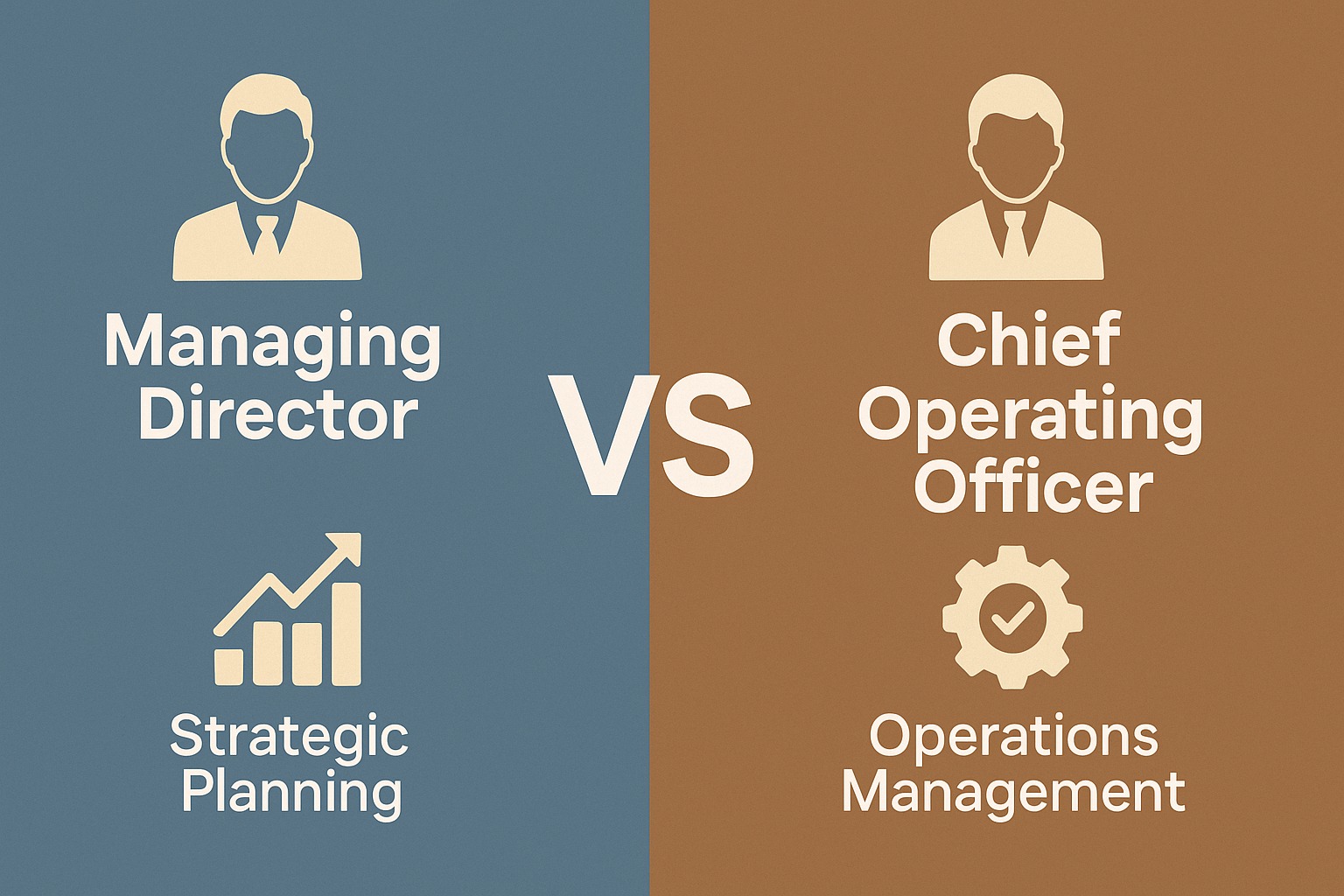Managing Director vs Chief Operating Officer: Understanding the Power Balance in Corporate Leadership
Unveiling the Roles, Responsibilities, and Strategic Importance of MDs and COOs in Business Success

Introduction
In any successful organization, leadership is the foundation. Two of the most influential leadership roles within a company are the Managing Director (MD) and the Chief Operating Officer (COO). While both positions command authority and carry significant responsibilities, they serve different purposes in the corporate structure. Understanding the distinction between these two roles is essential for anyone interested in Executive Leadership, Strategic Planning, or climbing the corporate ladder.
This article explores the differences, similarities, and strategic value of the Managing Director vs Chief Operating Officer, providing insight into their unique functions and how they drive organizational success.
What Is a Managing Director (MD)?
Role and Responsibilities
A Managing Director (MD) is often seen as the highest-ranking executive in an organization, particularly in countries like the UK and Commonwealth nations. In many cases, this role is synonymous with the Chief Executive Officer (CEO).
Key responsibilities include:
-
Creating and driving the company’s Business Strategy.
-
Leading the organization with Visionary Leadership.
-
Making high-level decisions about Market Expansion, Mergers and Acquisitions, and long-term growth.
-
Representing the company in external affairs and Stakeholder Management.
-
Overseeing all departments to ensure Financial Oversight, Profitability Analysis, and sustainability.
Strategic Importance
The MD is responsible for aligning every department’s goals with the overall Organizational Development plan. Their Communication Skills, Decision-Making, and ability to influence policy are critical for long-term success.
What Is a Chief Operating Officer (COO)?
Role and Responsibilities
A Chief Operating Officer (COO) typically acts as the second-in-command. The COO’s main focus is on ensuring the Operations Management of the business runs efficiently and aligns with the broader strategy set by the MD or CEO.
Core duties include:
-
Managing day-to-day operations.
-
Overseeing internal departments such as Supply Chain Management, Human Resources Management, and logistics.
-
Driving Process Improvement and Quality Assurance.
-
Implementing company-wide changes and optimizing Performance Monitoring.
-
Supporting Project Management to align with key business initiatives.
Operational Strength
The COO brings life to strategy. Where the MD sets the vision, the COO ensures it’s executed effectively. They are deeply involved in Risk Management, Change Management, and employee coordination, making them a cornerstone of internal success.
Key Differences Between MD and COO
Focus and Function
| Aspect | Managing Director (MD) | Chief Operating Officer (COO) |
|---|---|---|
| Focus | Long-term vision and company strategy | Day-to-day internal operations |
| Reports To | Board of Directors or Company Owner | CEO or MD |
| Decision Type | Strategic and visionary decisions | Operational and process-driven decisions |
| Team Involvement | Executive Leadership and Strategic Planning teams | Operations, logistics, HR, and finance teams |
| External/Internal Focus | Primarily external – investors, stakeholders, board | Primarily internal – processes, systems, and teams |
The MD often embodies Visionary Leadership and focuses on external relationships. The COO, however, thrives in Cross-functional Collaboration and detailed execution. Both roles require strong Team Leadership, but they apply it in different spheres.
Similarities Between MD and COO
Despite their differences, MDs and COOs share several overlapping qualities:
-
Both play a vital role in Organizational Development.
-
Require strong Communication Skills and Decision-Making abilities.
-
Drive Employee Engagement and help shape company culture.
-
Use Business Development strategies to achieve revenue goals.
-
Involved in high-level Budget Management and resource planning.
Their partnership ensures that strategy and execution stay aligned.
Where Do Other Executive Roles Fit?
Related Roles in the Executive Hierarchy
-
Chief Executive Officer (CEO): Usually the top authority; may also act as MD in some structures.
-
Executive Director: Sometimes used interchangeably with MD, especially in non-profits.
-
Director of Operations / General Manager / Vice President of Operations: Mid-level roles that support the COO in specific departments.
These roles act as bridges between the high-level strategy of the MD and the ground-level implementation led by the COO.
Strategic Impacts on Business Growth
Long-Term vs Short-Term Execution
-
The Managing Director is responsible for growth metrics, long-term success, and stakeholder vision.
-
The Chief Operating Officer focuses on executing the MD’s vision through measurable results.
Together, their collaboration ensures that goals such as Revenue Growth, Talent Acquisition, and Customer Satisfaction are realized in a timely and scalable manner.
FAQs About Managing Director vs Chief Operating Officer
Who has more authority, MD or COO?
The Managing Director usually holds higher authority, often reporting directly to the board and overseeing the entire organization. The COO reports to the MD or CEO and focuses on operations.
Can a company have both an MD and a COO?
Yes, many large organizations have both. The MD handles overall strategy and external relations, while the COO focuses on internal operations.
Is the COO a stepping stone to becoming MD?
In some companies, yes. The COO role prepares executives with hands-on experience in operations, making them strong candidates for future Executive Leadership positions.
What skills are essential for both roles?
Skills like Strategic Planning, Leadership, Communication, Problem-Solving, and Risk Management are essential for both MDs and COOs.
Are these roles industry-specific?
No. These roles exist across various sectors including finance, tech, manufacturing, healthcare, and non-profits.
Conclusion
Understanding the distinction between a Managing Director vs Chief Operating Officer helps clarify how companies balance strategy with execution. The MD focuses on the future — where the company is going. The COO ensures that the present — how the company gets there — is handled efficiently.
Both are essential to success. One crafts the vision; the other brings it to life.
Whether you’re aiming to become a future executive, analyzing company leadership, or simply trying to make sense of corporate titles, knowing these roles gives you a powerful edge.



